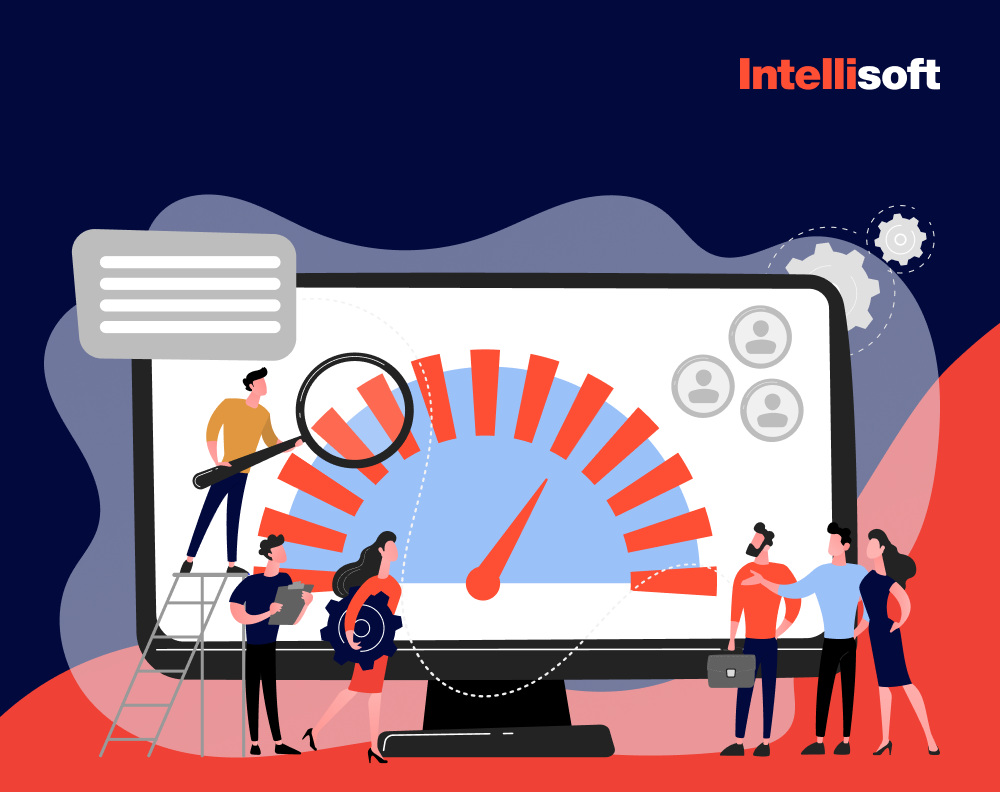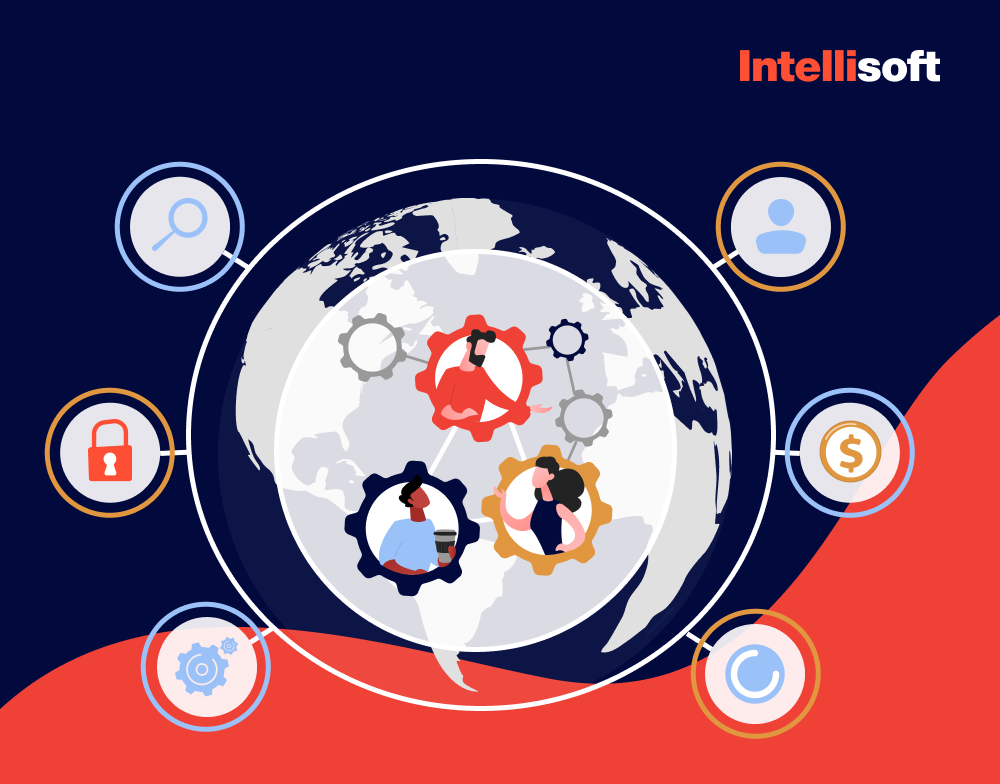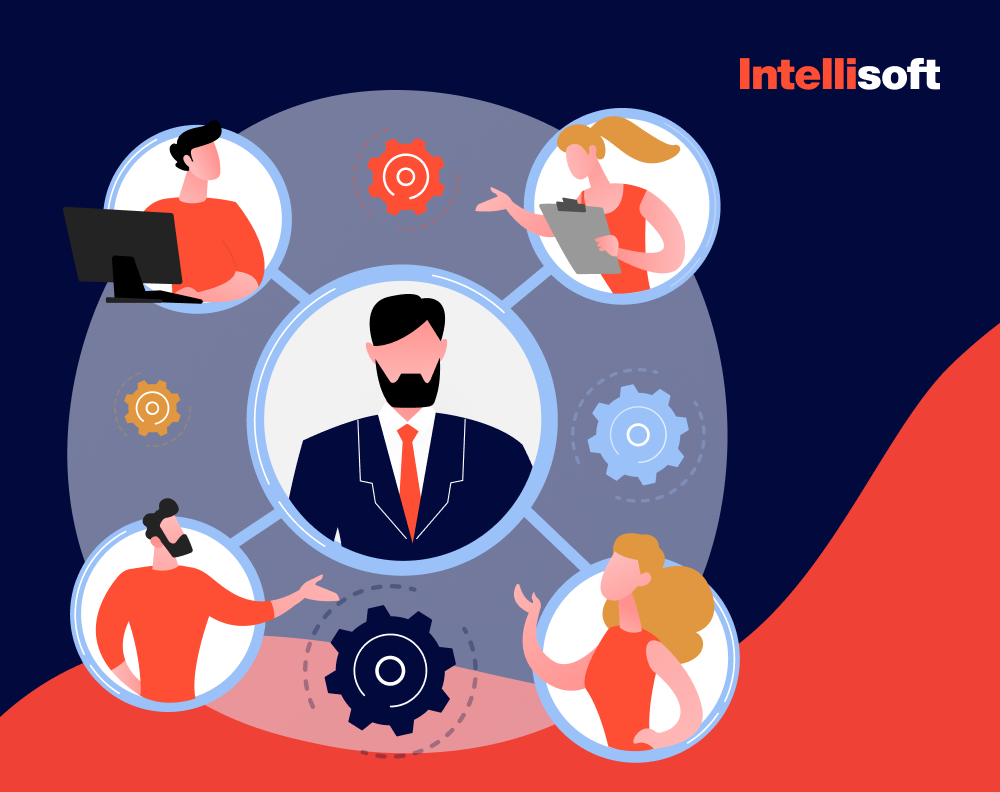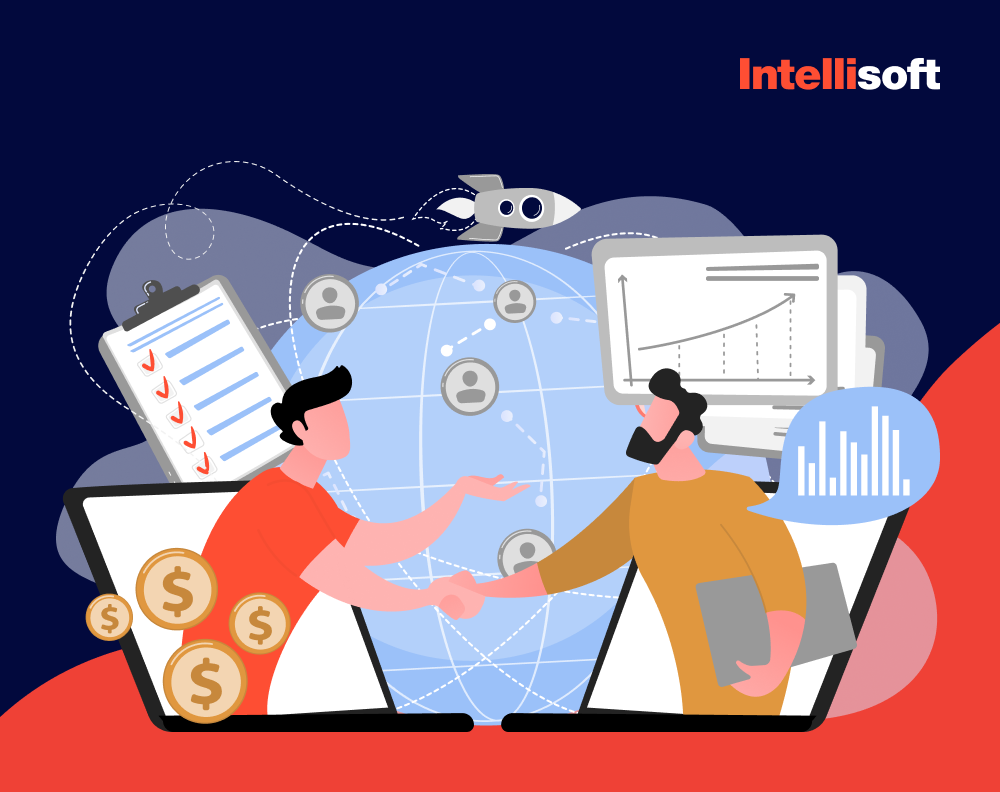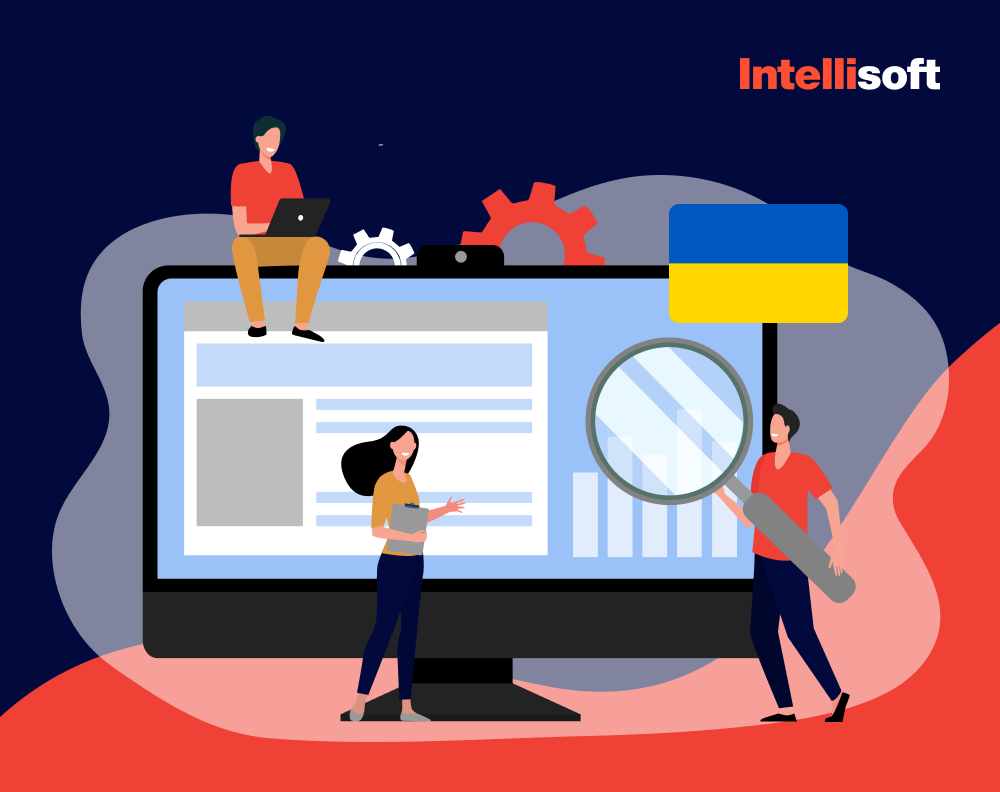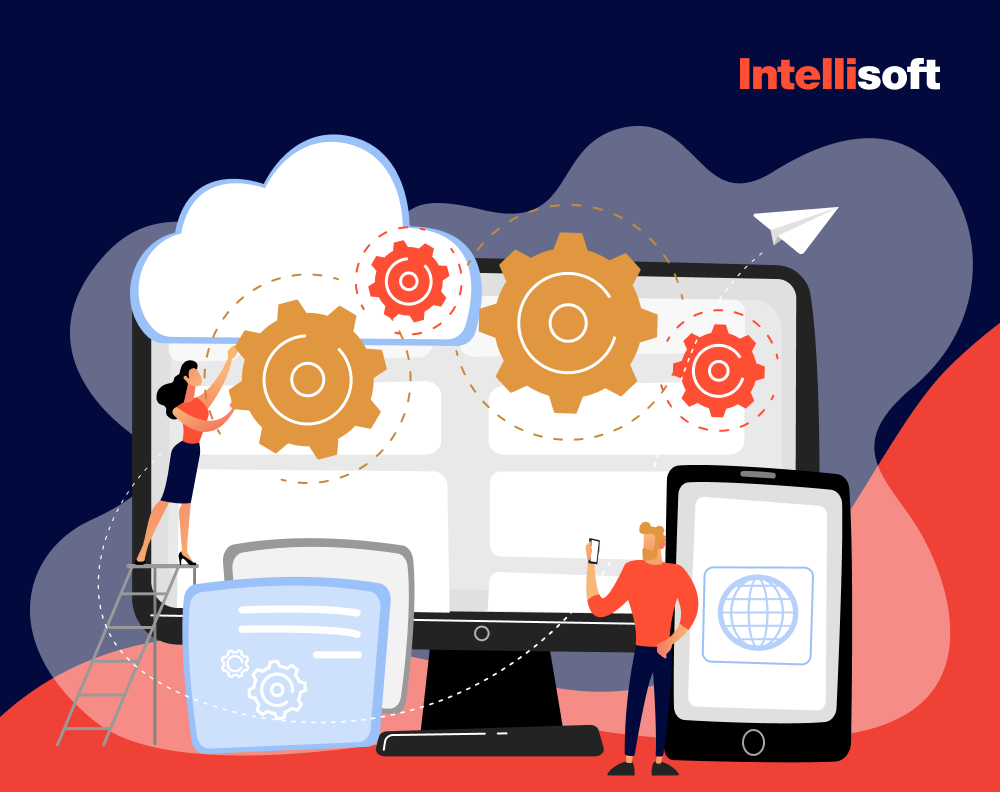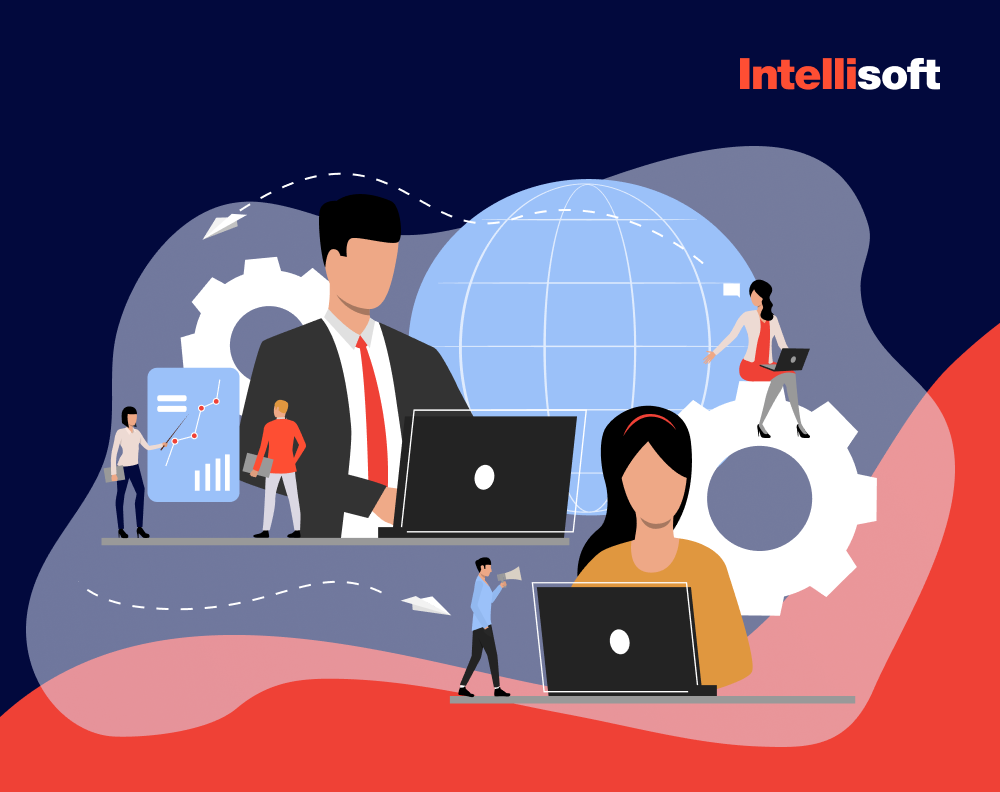In an era where digital transformation has become a survival mantra, software outsourcing has emerged as the go-to strategy for businesses racing to stay ahead. It may seem strange, but for many business leaders, one of the most crucial aspects of software outsourcing remains completely overlooked. We are talking about the total cost of ownership (TCO) for an IT product or service.
Total cost of ownership is the all-encompassing, often elusive measure that tells you the true cost of your outsourcing venture. TCO reveals not just the price tag but also the hidden expenses lurking beneath the surface.
When you fully understand total outsourcing IT costs, you receive a roadmap that can guide you through murky waters and effectively navigate the true costs of software outsourcing, from initial development fireworks to the maintenance marathon. You need the total cost of outsourced IT to make informed decisions.
And why should you lend an ear to us, IntelliSoft, your friendly neighborhood experts in software development outsourcing? Well, we’ve been around the block for a while now, juggling the nuts and bolts of IT solutions across continents. We know the ins and outs of this game. From Bulgaria to the U.S., Switzerland, and Ukraine, we’ve seen it all. We’re the experienced players who’ve mastered this art.
So, let’s peel back the layers of TCO in software outsourcing and uncover the secret of winning in this game of strategic growth and innovation.
Table of Contents
What Is Total Cost of Ownership (TCO) in Software Outsourcing?
The concept of total cost of ownership (TCO) in software outsourcing is as critical as it is complex. So, let’s demystify this approach that allows you to paint a more accurate picture of the investment that you need to plan for your project.
Explanation of TCO and Its Components
First coined by the Gartner Group back in the 1980s, TCO became the universal tool of financial analysis in software engineering. You need to take into account all the factors, not just what you pay upfront. You need to understand the full spectrum of costs, both direct and indirect, associated with a system throughout its life cycle.

From the initial development to ongoing maintenance and support, total costs of outsourcing IT compel us to look beyond the sticker price and consider the entire financial footprint of our software outsourcing endeavors. Let’s talk about the key elements that contribute to the overall cost of software development outsourcing.
Development Costs
The story begins with development costs. This is the “face value,” the price tag you first see. It includes everything from coding to testing the software. But remember, development is just the tip of the iceberg.
Maintenance and Support
After the fanfare of the launch, maintenance and support take center stage. This ongoing cost keeps your software running smoothly, adapting to new needs and fixing any hiccups along the way.
Bug Fixes and Troubleshooting
Ah, bugs – the uninvited guests in software. Bug fixes and troubleshooting are like the pest control of the software world. Regular checks and updates are essential to keep your software bug-free.
Training
New software? You’ll need training. This often-overlooked cost ensures your team can actually use the software effectively. After all, what good is a fancy tool if no one knows how to wield it?
Onboarding
Onboarding is about integrating new software into your existing ecosystem. It’s like introducing a new member to your family – it takes time and effort to blend seamlessly.
Infrastructure and Technology
Then comes the backbone – infrastructure and technology. These are the servers, storage, hosting, cloud services, and network systems that form the foundation of your software’s home.
Security Measures
In our digital age, security is paramount. It is important to invest in strong security measures to protect your data and reputation. You need to ensure that sensitive information is kept safe and secure and that your brand and reputation are not compromised.
Integration Expenses
Integration expenses are the costs included to ensure your new software plays well with the existing systems. It’s like a diplomatic mission, ensuring all your technological entities are in harmony.
Data Protection
Data is the new gold, and protecting it is not optional. Data protection costs ensure your valuable information is safe from prying eyes and accidental losses.
Compliance and Audits
Last but not least, compliance and audits. These are the rules of the road, ensuring your software meets industry standards and regulations.
Outsourced IT Support Costs
We strongly recommend considering the outsourced IT support costs. It’s not just about fixing issues; it’s good to have a reliable team on standby to ensure smooth operations. This cost, while sometimes out of sight, should never be out of mind.
Customer Service Outsourcing Costs
Similarly, customer service outsourcing costs are crucial. This is the frontline of your user experience. Skimping here can cost you not just money but also customer loyalty.
Understanding total costs of outsourcing IT is like assembling a complex puzzle. Each piece, whether visible or hidden, plays a critical role. Remember, in the realm of software outsourcing, the cheapest option isn’t always the most cost-effective in the long run. Total cost of outsourced IT helps you see the full picture, ensuring that you’re not just saving money but also investing it wisely.
Importance of TCO in Software Outsourcing
Dive deep into the domain of total cost of ownership in software development outsourcing, and you’ll discover it’s much more than a mere financial metric. It’s a principle that can guide your strategic decisions. It can show you the path beyond just initial costs and reveal hidden benefits and lurking risks. Let’s explore why the analysis of total costs of outsourcing IT is indispensable in the world of software outsourcing.
TCO: More Than Just Initial Development Costs
Picture TCO as an iceberg. What you see above the water, the initial development costs is just a small part of the story. Beneath the surface lies the bulk of your expenses, spanning across the software’s lifespan. These additional expenses include ongoing maintenance, updates, support, and even the eventual retirement of the software.
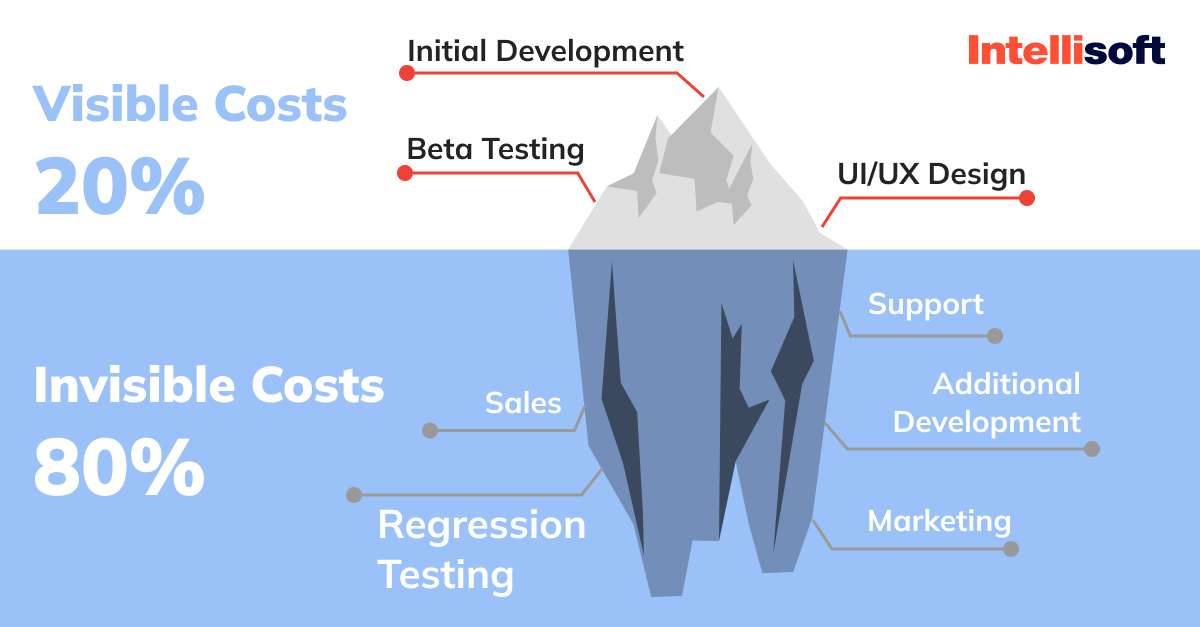
TCO teaches us to look beyond the attractive price tag of initial development. It’s easy to get dazzled by a low upfront cost, but the total cost of outsourced IT nudges us to consider the long game. What seems cheap now might turn into a costly affair down the line with additional requirements, scalability needs, and evolving technology trends.
Unearthing Hidden Costs and Potential Risks
One of TCO’s greatest contributions is its ability to shine a spotlight on the often-overlooked or hidden costs. These are the silent budget-drainers that can sneak up on you if not accounted for from the start.
Hidden costs in software outsourcing can take many forms. They range from the seemingly minor (like additional training for new updates) to significant expenditures (like compliance with new data protection laws). These hidden costs are like termites, slowly chipping away at your budget’s foundation. TCO helps you identify them early, preventing surprises that could derail your project.
Potential risks are another critical component that TCO helps to uncover. These risks could be technological, such as software becoming obsolete, or operational, like a mismatch in the time zone affecting the project timeline. By considering these risks, TCO equips you to make contingency plans, ensuring smoother sailing.
Holistic Decision-Making with TCO
TCO isn’t just about counting costs more accurately. With the help of this tool, you can gather all the necessary information and data to make well-informed and strategic decisions that will perfectly align with the goals and objectives of your business. It encourages a holistic view, considering every aspect of the outsourcing process.
Strategic Alignment
By understanding TCO, you align your software outsourcing with your business strategy. You can build a detailed plan for your investment, ensuring every dollar spent moves you closer to your goals. Whether it’s expanding your market reach, enhancing customer experience, or driving innovation, TCO ensures your outsourcing efforts become an investment that propels you closer to your strategic objectives.
Long-Term Planning
With TCO, your decision-making transcends short-term gains. You start planning for the long haul, considering how your outsourcing decisions will impact your business in the years to come. It’s like planting a tree – you don’t just think about the shade it offers today but the fruit it will bear in the future.
Maximizing ROI
Ultimately, TCO is about maximizing your return on investment (ROI). Thanks to accurately estimated TCO, you can consider all costs and align them with your business strategy. TCO ensures that every dollar you put into software outsourcing yields the maximum possible value. Your goal is not just to save money. You need to spend them smartly to fuel growth and innovation.
By allowing you to look beyond initial costs, identify hidden expenses and risks, and align outsourcing efforts with your long-term business goals, TCO emerges as an essential tool for maximizing ROI.
Related readings:
- In-House vs. Outsourcing Software Development Teams
- Nearshoring Business-Processes Outsourcing
- How to Overcome Risks of Outsourcing?
- How to Sign a Contract with an IT Outsourcing Agency
- IT Offshore Outsourcing: Key Pros and Pros
Step-by-Step Guide to Calculating TCO in Software Outsourcing
Launching an outsourcing software development project without a clear understanding of the total cost of ownership is like setting sail without a map. You can use our step-by-step guide to calculating TCO and then navigate the financial seas smoothly. Here’s how you can assess your project costs with precision.
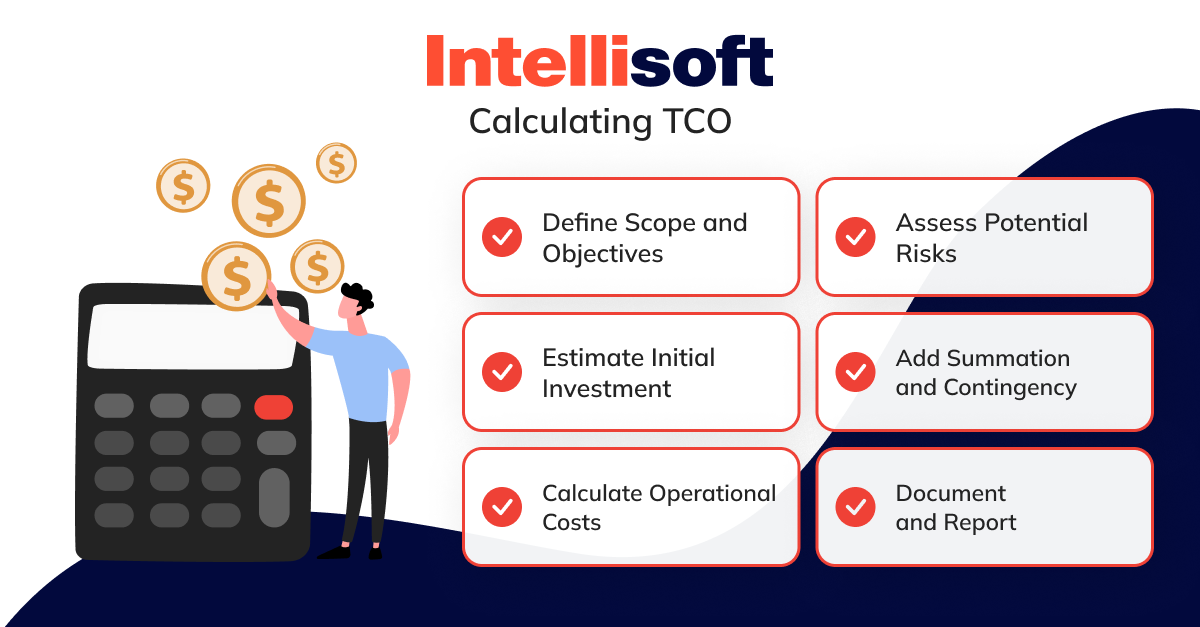
Step 1: Define Scope and Objectives
The first step is to precisely define what you want your software outsourcing project to achieve. Just like setting a destination for a voyage, defining the scope and objectives gives direction to your cost analysis.
- First, assess whether the project involves full-scale development from scratch or updating and enhancing existing software. This determination significantly influences the complexity and resources required.
- Define the extent of the work in detail. For a new development, this might include foundational work like setting up databases and basic functionality. For updates, it could involve integrating new features into existing systems.
- Itemize the key components of the software solution. This includes development but also extends to maintenance, support, bug fixes, and potential scaling or updates post-deployment.
- Analyze if the new software will be able to work seamlessly with the current infrastructure. Does it require additional components for compatibility or data migration efforts?
- Ensure that the objectives of the software project are in direct alignment with your broader business goals. Are you aiming for increased efficiency, market expansion, or innovation in a particular area? Your objectives here should reflect these goals. This alignment is crucial for identifying relevant costs and avoiding unnecessary expenditures. It helps in focusing resources on areas that directly contribute to achieving these goals and optimizing the overall investment.
Step 2: Estimate Initial Investment
The initial investment is the cornerstone of your software outsourcing project. It encompasses a range of costs that lay the groundwork for your development journey. Here’s a more detailed breakdown:
- Begin by breaking down the costs associated with the actual development of the software. This process includes coding, design, and testing phases. Each of these areas requires specialized skills and resources, which should be quantified for a thorough estimate.
- Include any licensing fees for software or technologies that will be utilized in the project. Additionally, account for upfront payments or initial fees that are part of the agreement with your outsourcing partner.
- Factor in the costs of acquiring necessary hardware and software licenses. Depending on the project’s nature, this list could include everything from basic computing equipment to specialized development tools.
- Consider the investments required for server setup or cloud services. If your project demands specific technology infrastructure such as dedicated servers or cloud storage, these costs need to be included.
- Estimate the costs involved in training your in-house team to use or manage the new software. You may need to include instructional materials, external training sessions, or workshops.
- Onboarding costs ensure a smooth transition and integration of the software into your existing systems. This initial phase of the project may require additional resources or tools.
- Legal fees can sometimes be overlooked in the initial cost estimation. Include the expenses for contract negotiation, compliance checks, and any other legal aspects associated with the outsourcing agreement.
- This way, you ensure that all contractual and legal bases are covered and safeguard your project from potential legal problems.
Step 3: Calculate Ongoing Operational Costs
Once your software is operational, the next crucial step in calculating TCO is to assess the ongoing operational costs. These are the expenses that will recur throughout the lifespan of the software, ensuring its smooth operation, security, and relevance to your business needs.
- Include the costs for regular software updates and version upgrades. They are essential for keeping the software current and functional.
- Allocate a budget for addressing unexpected software glitches and bugs. Don’t forget about user support, which is critical for resolving any issues that users encounter.
- Add regular expenses related to hosting services, server maintenance, and cloud services. These are vital for the uninterrupted operation of your software.
- Consider the costs for periodic technology upgrades or integrations. As the tech landscape evolves, your software might require updates to remain compatible and efficient.
- Cybersecurity is non-negotiable in today’s digital age. Estimate the costs associated with continuous monitoring and regular updates to your security protocols.
- Include any investments in advanced cybersecurity measures. You may need specialized software, hardware, or services to safeguard your data and operations.
- As the software evolves, your staff may need additional training. Include expenses on onboarding new users and training existing staff on new features or updates. Training should be an ongoing process to ensure
- that your team is always equipped to utilize the software to its full potential, especially as it adapts and grows over time.
Step 4: Assess Potential Risks and Their Financial Implications
When outsourcing software development, foreseeing and preparing for potential risks is as crucial as planning for success. This step in the TCO calculation involves a thorough risk assessment to anticipate and mitigate factors that could impact your project financially.
- Start by identifying potential risks across the spectrum – technical, operational, and strategic. Think about everything from software compatibility issues to disruptions in workflow.
- Consider risks related to the performance and reliability of your outsourcing partner. Cultural differences, communication barriers, and differing work ethics can also pose significant challenges.
- Stay aware of the risks posed by changes in regulatory environments, which can affect the compliance and legal standings of your software solution.
- For each identified risk, evaluate both its potential impact and the likelihood of occurrence. Prioritize the risks based on their potential financial implications and their relevance to the success of the project. Focus resources on mitigating the most critical risks.
- Estimate the potential financial consequences of each identified risk. Quantify the impact in terms of additional costs, project delays, or even potential revenue loss. Some risks might have a cascading effect, impacting multiple aspects of the project. Account for these in your financial impact analysis.
- Develop strategies to mitigate each identified risk. You might need contingency planning, investing in additional resources, or altering project timelines. It’s crucial to include the costs associated with these risk mitigation strategies in the overall IT outsourcing price calculation. They form an essential part of your financial planning and can safeguard your project from unexpected setbacks.
Step 5: Add Summation and Contingency
The next step in calculating the total cost of ownership is a critical juncture where all your detailed estimates come together. Now, you can form a comprehensive financial picture of your software outsourcing project. This step is about summing up all costs and establishing a contingency plan to buffer against uncertainties.
- The task here is to compile all previously calculated costs – initial investment, ongoing operational costs, and the financial impact of potential risks. This summation gives you the total expenditure expected throughout the life cycle of the outsourced software.
- After summing up the costs, it would be wise to allocate a contingency fund. It will serve as a financial cover for unforeseen circumstances or changes in project requirements that weren’t apparent during the initial planning stages.
- A good rule of thumb is to include a percentage of the calculated IT outsourcing price as your contingency reserve. The precise percentage may differ based on the intricacy and risk factors of the project but typically ranges between 10-20%. The purpose of this fund is to provide a financial cushion that can protect the project from unforeseen expenses.
Step 6: Document and Report
Detailed documentation and reporting of the TCO calculation process are crucial for transparency and future reference.
- Keep a record of all calculations, assumptions, and sources of data. This documentation is vital for revisiting and revising cost estimates.
- Regularly update all stakeholders on the financial status of the project. Transparent reporting helps in managing expectations and making informed decisions.
By following these detailed steps, you can create a comprehensive map of your software outsourcing journey. This thorough approach to calculating TCO sheds light on the true cost of your project and provides you with the needed information for making informed, strategic decisions.
Factors Influencing TCO in Software Outsourcing
Choosing an offshore outsourcing software development partner is more than just a hunt for the lowest bid. Deciding whether to outsource your software project to an offshore company can be complex, as it involves weighing various factors that can significantly impact cost and success. Let’s explore five key elements that critically influence the overall IT outsourcing price in software outsourcing partnerships.
Geographical Location of Outsourcing Partners
The geographical location of your outsourcing partners plays a pivotal role in determining the TCO. Labor costs, infrastructure expenses, and the economic conditions of a region can drastically affect the overall cost of software development.
When selecting an outsourcing partner, it’s important to align their location with your business goals and budget. Labor costs can vary dramatically between countries, influencing the overall cost of the project. You need to understand the economic landscape of the outsourcing partner’s location. Evaluate such factors as currency exchange rates, local taxation, and the cost of living, all of which can impact the final cost of your project.
IntelliSoft’s global presence, with offices in strategic locations like Bulgaria, the U.S., Switzerland, and Ukraine, offers a unique advantage in managing total outsourcing IT costs. Our locations are selected based on their balance of competitive labor costs and high-quality infrastructure, providing clients with cost-effective solutions without compromising quality.
Quality of Talent and Expertise
The outsourcing team’s expertise directly impacts the project’s total cost of ownership. A skilled team may charge more but can save time and money in the long term with better output quality.
Assess the qualifications, experience, and portfolio of the outsourcing team; making sure they have the necessary expertise and track record can lead to successful project delivery and avoid costly revisions or project delays.
At IntelliSoft, the quality of our talent pool is a primary driver in optimizing TCO for our clients. Our expertise translates to reduced development times and a higher caliber of output, offering long-term cost savings.
Time Zone Differences and Their Impact
Time zone differences can be a significant factor in software outsourcing, affecting everything from communication to project deadlines. Varying time zones can lead to communication delays and coordination challenges. However, they can also offer benefits like round-the-clock work cycles if managed effectively.
IntelliSoft turns time zone differences into an advantage for our clients. We employ efficient project management and communication tools that help bridge the gap caused by time zone differences. Establishing overlapping working hours facilitates real-time collaboration and quick decision-making.
Cultural and Communication Considerations
Effective communication and cultural compatibility are crucial for the success of any outsourcing partnership. Understanding and respecting cultural differences can enhance collaboration. It’s important to establish a common ground and foster a working environment that respects diverse viewpoints and working styles.
Language barriers can lead to misunderstandings and inefficiencies. Ensuring that the outsourcing team is proficient in a common language and familiar with your communication style is essential.
Our teams are trained to work in culturally diverse settings, ensuring smooth collaboration and minimizing misunderstandings. With a focus on English proficiency and effective communication styles, IntelliSoft bridges language gaps, ensuring clarity in all interactions.
Legal and Compliance Factors
The legal and compliance landscape of software outsourcing can greatly impact IT outsourcing price, particularly when unforeseen legal challenges arise. Clearly defined contracts that outline the scope, deliverables, timelines, and payment terms are vital. They should also cover aspects like intellectual property rights and confidentiality.
To avoid legal complications, you need to understand and adhere to international laws and regulations. Make sure to check data protection laws, employment laws, and industry-specific regulations.
IntelliSoft ensures transparent and comprehensive contracts, adhering to international laws and regulations, which safeguard our clients from potential legal risks. Our adherence to global compliance standards and commitment to data protection offers us peace of mind.
IntelliSoft recognizes all of the critical factors influencing total outsourcing IT costs in software development and actively harnesses its global resources, expert talent, and strategic insights to turn these factors into advantages for our clients. Partnering with IntelliSoft means choosing a path that leads to quality, innovation, alignment with your goals, and ultimately cost savings.
Strategies for Minimizing TCO in Software Outsourcing
In the intricate dance of outsourcing software development, minimizing the total cost of ownership isn’t just about cutting costs. It’s about smartly investing resources for maximum efficiency and returns. Let’s discuss some of the most effective strategies that can help you achieve this balance.

Selecting the Right Outsourcing Partner
The success and budget of your project can depend on selecting the right outsourcing partner. You need to match your partner’s expertise with your needs. Look for a partner whose expertise aligns with your project requirements. A mismatch here can lead to increased costs due to a lack of understanding or inefficiency.
Evaluate the potential partner’s past projects and client testimonials. A proven track record is often indicative of their ability to deliver quality work within budget.
Negotiating Favorable Contracts and Terms
The art of negotiation lies at the heart of cost-effective outsourcing. Ensure that the contract clearly defines the project scope, deliverables, timelines, and payment terms. Ambiguities can lead to unexpected costs later on. Negotiate terms that offer flexibility and scalability. This approach helps in adapting to changing project requirements without incurring significant additional costs.
Implementing Efficient Project Management Practices
Efficient project management is crucial in keeping costs under control while ensuring timely delivery. Agile methodologies provide flexibility and regular feedback loops, enabling early identification and resolution of issues, thereby preventing costly overruns. Leverage modern project management tools for better coordination, communication, and tracking. These tools can help in maintaining a clear overview of the project’s progress and budget.
Investing in Preventive Measures to Mitigate Risks
Preventive measures are your safeguard against unforeseen costs and project derailments.
Regularly assess potential risks and develop mitigation plans. You need backup plans, data protection strategies, and contingency funds. Implement regular audits and quality checks throughout the project lifecycle. Catching errors early can prevent costly fixes down the line.
By adopting these strategies, you can significantly minimize the TCO of your software outsourcing projects. These approaches ensure cost-effectiveness and contribute to the overall success and quality of the outsourced software solution.
Conclusion
We’ve reached the end of our rollercoaster ride through the world of total cost of ownership in software outsourcing. The concept of TCO acts as the crystal ball that helps you foresee the true costs of your project and accurately forecast your future investments. It’s your crucial tool for strategic decision-making.
Consider all costs, including development, maintenance, legal & compliance, to make informed decisions to optimize resources & maximize software investment value.
A thorough total outsourcing IT costs analysis empowers your company to make financially sound decisions that allow you to achieve broader business objectives, such as innovation, market expansion, and operational efficiency.
If you want to embrace TCO and pave the way for your long-term success and sustainability in your software outsourcing projects, partnering with IntelliSoft for software development becomes a game-changer. IntelliSoft stands as your perfect partner in this journey, offering our expert IT services, our experience, and commitment needed to maximize the benefits of your software outsourcing investments. Contact us today to take the first step toward your strategic goal.


